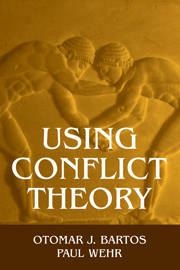Book contents
- Frontmatter
- Contents
- List of Figures and Tables
- Acknowledgments
- 1 Introduction
- 2 Understanding Conflict
- 3 Development of Incompatible Goals
- 4 Application to the Civil Rights Struggle
- 5 Emergence of Overt Conflicts
- 6 Application to a University Conflict
- 7 Escalation and Deescalation
- 8 Application to Conflict in Bosnia
- 9 Making Conflict Work Economically
- 10 Understanding and Managing Conflicts
- Appendix: Prelude to the Dissolution of Yugoslavia
- Notes
- References
- Index
5 - Emergence of Overt Conflicts
Published online by Cambridge University Press: 05 June 2012
- Frontmatter
- Contents
- List of Figures and Tables
- Acknowledgments
- 1 Introduction
- 2 Understanding Conflict
- 3 Development of Incompatible Goals
- 4 Application to the Civil Rights Struggle
- 5 Emergence of Overt Conflicts
- 6 Application to a University Conflict
- 7 Escalation and Deescalation
- 8 Application to Conflict in Bosnia
- 9 Making Conflict Work Economically
- 10 Understanding and Managing Conflicts
- Appendix: Prelude to the Dissolution of Yugoslavia
- Notes
- References
- Index
Summary
before December 7, 1941, relations between Japan and the United States were strained, but no overt hostilities existed. Then came the Japanese attack on Pearl Harbor, and the ensuing war between Japan and the United States. Why did the hidden hostilities change into an open war? Was it caused by the attack on Pearl Harbor?
Generally speaking, for an open conflict to emerge, two main conditions are needed: the formation of “conflict groups,” and a sequence of events that ignites conflict action. Dahrendorf (1959) addressed the problem of conflict group formation in considerable detail. He argued that groups whose goals are incompatible but who do not realize it, will become full-scale conflict groups if each of them (1) has leaders committed to the conflict, (2) has a conflict ideology, (3) is free to organize for conflict, and (4) has members who can communicate with each other. Dahrendorf's four conditions exist in groups that, in addition to having incompatible goals, have high conflict solidarity and sufficient conflict resources.
Conflict Solidarity
We noted in Chapter 3 that free communication produces socalled communal values. But free communication can also promote conflict solidarity.
Free Communication as a Cause of Solidarity
Sociologists usually distinguish between individuals who form a group and those who do not: if they interact with each other fairly regularly, they form a group; if they do not interact, they don't.
- Type
- Chapter
- Information
- Using Conflict Theory , pp. 70 - 82Publisher: Cambridge University PressPrint publication year: 2002



